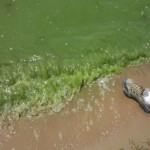
In freshwaters around the world blooms of cyanobacteria (commonly known as blue-green algae) are considered a serious health problem due to their potential to release toxins that can poison and kill humans, pets and livestock. What controls the growth of these cyanobacteria and their associated toxicity? New NCCOS-sponsored research shows how harmful cyanobacteria blooms in freshwater are formed and how these blooms can become toxic.
At Stony Brook University, graduate student Matthew Harke and Professor Christopher Gobler used a novel genetic analysis for the first time on the common and sometimes toxic cyanobacteria Microcystis aeruginosa. The new study shows the importance of both phosphorus and nitrogen in controlling growth of Microcystis and, just as significant, the role of nitrogen in controlling its toxicity. In addition, the study shows the genetic adaptability of Microcystis to utilize both inorganic (soil-derived) and organic (organism-derived) forms of phosphorus and nitrogen. The findings demonstrate the importance of limiting both phosphorus and nitrogen into freshwater bodies.
The results of this study were published July 23, 2013 in the open-access online journal PLoS One Global Transcriptional Responses of the Toxic Cyanobacterium, Microcystis aeruginosa, to Nitrogen Stress, Phosphorus Stress, and Growth on Organic Matter. The research was funded by the NCCOS Ecology and Oceanography of Harmful Algal Blooms (ECOHAB) Program. For more information, contact Marc.Suddleson@noaa.gov.
